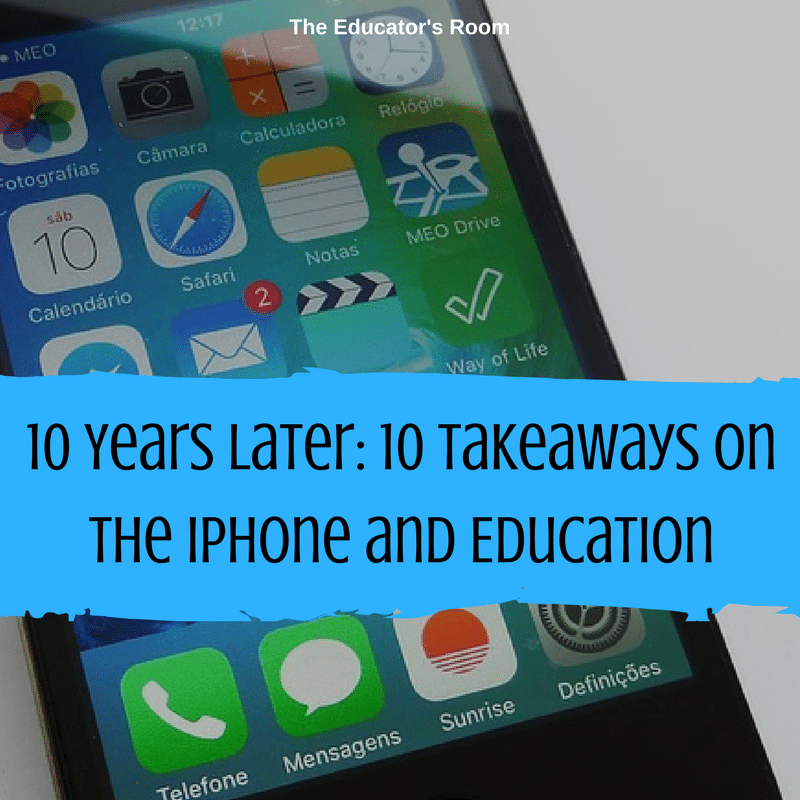Ten years ago this month, Steve Jobs walked out onto the world’s stage and said “this is a day I’ve been looking forward to in 2.5 years” because of this “revolutionary product that absolutely changes everything.” I’m talking about the iPhone. And boy, did it change everything.
Today, nearly 7 in 10 adults has a smart phone, a number that increases to 89% in the 19-39 age range. And for students aged 11 and up, 73% of these young minds have access to a smart phone. The smart phone has become so ubiquitous that 51% of college students have said “they can’t imagine life without them.” This omnipresence of the device has crashed the career (and marriage) of Anthony Weiner, one of the Democratic Party’s rising stars, while providing a medium for President-Elect to communicate with the world (he has stated he “won’t give up his Android” when he assumes office). But what has it done to schools?
The jury is still out, but one can argue the smartphone’s impact in two ways:
For some, it has become a weighing anchor in education. Here are 5 examples:
- It’s no secret that attention-deficit disorders are rising at the same clip as smartphone usage. The question is their relativity to one another.
- The intense addiction of the device has also been pointed out. For some teachers, as the Atlantic Magazine reports, it’s like “giving students access to cigarettes and candy;” they don’t know what to do with this power. I wonder that power when I look at my 15-month-old son, who still has yet to interact with a device (and won’t until he’s at least 2 – or probably much older – per the AMA’s advice). I’m not yet ready to see his head slooped over the smart phone.
- When a Ohio university created a study on smart phone usage, the used three test groups: those permitted to openly use their device, those only permitted to use the phone related to class, and those who were prohibited to use the phone at all, the vast gaps in retaining a lecture were astounding. It’s no surprise those most engaged in the lecture (and disengaged from their phones) learned the most. [bctt tweet=”The iPhone has become a weighing anchor in education” username=”EducatorsRoom”]
- This addiction is making students more depressed, anxious, and disconnected from their peers, family, and society. How else would “Slender Man” be able to take off as a “thing?” Yet, I hate to break it to my fellow educators – you’re just as (and maybe more) addicted as the kids.
- Lastly, the phone as a video recorder has become a fear for all teachers. Though there aren’t many documented instances of students filming teachers, with the constant filming of police officers, the fear is there. Just YouTube search “horrible teacher” and, if you didn’t have that fear before, now you probably will.
For others, the smart phone has revolutionized the classroom as a sail. Here are another 5 examples:
- In a world filled of draining educational resources, the smart phone has become the go-to resource that students are already adept at using and can use anywhere. It jumps over language gaps – and instead through Google Translate – plugs them. The next time someone says “OK Google” or “Hey Siri” – you’ll know exactly what I’m talking about.
- The power of applications (yes, the formal term for apps) has unlocked a wealth of experiential learning. My students can now take a virtual field trip in Independence Hall, roam the moon, digitally dissect a frog, play educational math games, and more.
- Online textbooks and media have made up-to-date and best-practice curriculum so easily attainable that the old encyclopedias that used to sit in our library not just outdated, but outrageous. To boot, digital textbooks are (up to 50%) cheaper and can be updated from year-to-year.
[bctt tweet=”the smart phone has revolutionized the classroom” username=”EducatorsRoom”]
- The ability to so easily video has made students into their own filmmakers, and the language of YouTube (which is very strongly their method for watching and consuming media – in that 91% of teens use YouTube once a week). We can not only teach them the content in the best way they learn, but provides students the capacity to create projects that are in their own language. Similarly, if a student misses class, devices like the Swivl or ideas like flipped classrooms create the ability to keep continually active students involved in the classroom community.
- Social media has given educators the ability to work together to trade ideas. Now teachers who are pursuing common goals or have similar experiences can lean on one another. I’ve already hosted an #sschat on Twitter solely from my smart phone. In fact, I imagine most of our readers are probably reading this article on that device, too.
While the jury is still out on the role, impact, and usability on devices on student classroom learning, the truth of the matter is, smart phones are here to stay. NEA offers a few tidbits of advice on using the technology in the classroom, and there is a blog that I found to be pretty useful, but the truth is the smart phone has wielded tremendous power in the changing face of education in the time since Mr. Jobs debuted it 10 years ago. Where it goes from here will largely be thanks to – or in despite of – our leadership as educators.
In conclusion, what grade would you give the smartphone for changing the face of education? Has it been an A+ positive? A true failure? Somewhere in the middle? Let us know in the comments and on social media comments section.







